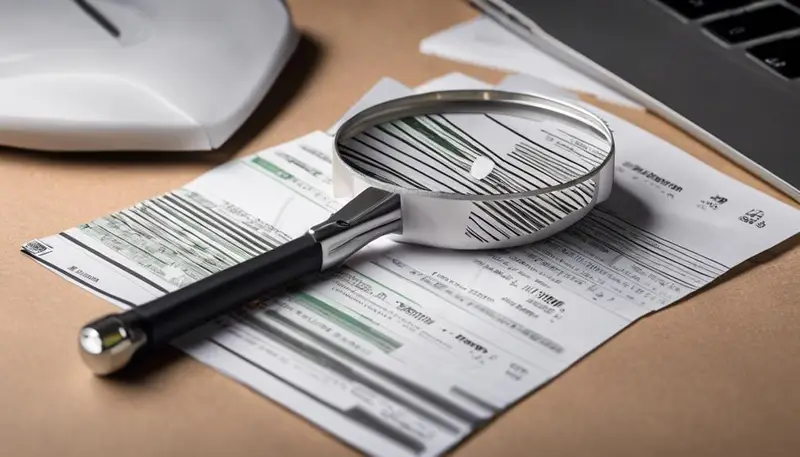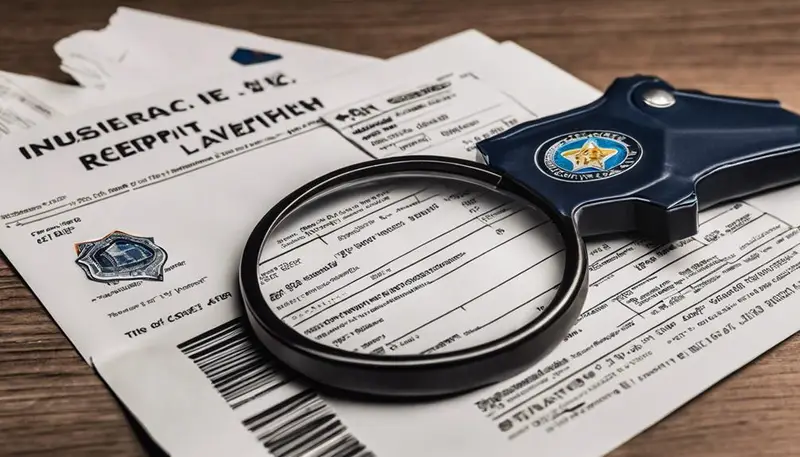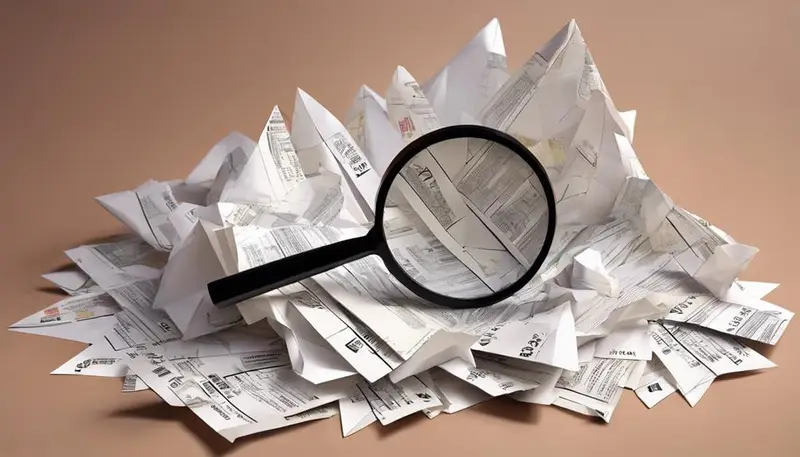In the intricate process of claims verification, insurance companies deploy a multifaceted approach to ensure the authenticity of receipts submitted by claimants. This involves not only a meticulous examination of the paperwork for inconsistencies but also the integration of digital verification methods and forensic analysis to scrutinize the veracity of each claim.
As the industry evolves, so do the techniques to detect and deter fraudulent activities, raising intriguing questions about the balance between rigorous scrutiny and the trust placed in policyholders. It beckons a closer look at the sophisticated methodologies employed, revealing the complexities and challenges that lie within the realm of insurance claims verification.
Key Takeaways
- Insurance companies use technology to cross-reference receipts with online databases and bank records for verification.
- They scrutinize receipts for inconsistencies, focusing on purchase dates, items bought, and payment methods.
- Forensic examination techniques, including analysis of ink and paper, are employed to detect altered or fraudulent receipts.
- Direct verification with vendors and meticulous comparison with vendor records are critical in confirming the authenticity of purchases.
Digital Verification Methods
In an era where digital transactions are ubiquitous, insurance companies increasingly rely on digital verification methods to authenticate receipts submitted by policyholders. This modern approach leverages the power of technology to cross-reference receipts with vast online databases and comprehensive purchase records, ensuring their validity. By comparing the intricate details of receipts against electronic transaction data, insurers can effectively detect any inconsistencies or discrepancies that may suggest fraudulent activities.
The utilization of advanced software tools plays a pivotal role in this process. These tools are designed to meticulously analyze the metadata embedded within receipts, a technique that helps in identifying potential signs of manipulation or fraud. This digital scrutiny extends beyond mere visual inspection, delving into the digital footprints left by electronic transactions. It offers a robust solution to one of the insurance industry's most pressing challenges: the prevention of fraud related to receipt submissions.
Manual Receipt Examination

Following the exploration of digital verification methods, the focus shifts to Manual Receipt Examination, a vital process within the insurance sector.
This procedure involves a meticulous inspection of receipts to validate the authenticity of claims and detect any discrepancies that may suggest fraudulent activities.
Receipt Authenticity Checks
To ensure the legitimacy of claims, insurance companies meticulously examine receipts for any signs of alteration or inconsistency. This manual examination process involves scrutinizing receipts for any discrepancies, such as altered amounts or details that could indicate fraud.
By carefully comparing the information on receipts with bank records and credit card statements, insurers can confirm the authenticity of purchases and ensure that the amounts claimed match actual transactions. This level of detail is crucial in preventing fraudulent claims and safeguarding against receipt fraud.
Through this rigorous process, insurance companies can detect any attempt to manipulate or falsify information, thereby maintaining the integrity of claims and protecting both the insurer and the insured from potential financial losses.
Detail Verification Process
Insurance companies engage in a meticulous manual examination of receipts, focusing on details such as purchase dates, items bought, and total amounts to ensure the accuracy and authenticity of claims. This thorough scrutiny is pivotal in validating the legitimacy of each claim, safeguarding against potential discrepancies and ensuring that payouts accurately reflect the insured events.
- Vendor Verification: Insurers verify the details of the vendor, including the purchase made and the payment method used, to ensure transactions are legitimate.
- Cross-Checking Bank Statements: Transactions on receipts are cross-referenced with bank statements to confirm their occurrence and detect any irregularities.
- Retailer Confirmation: Contacting retailers directly can confirm the specifics of the purchase, including delivery dates and return policies, adding an additional layer of verification.
Fraud Detection Methods
Fraudulent claims pose a significant challenge to insurance companies, which often deploy manual receipt examination as a primary method of detection to ensure claim legitimacy. By meticulously analyzing details such as purchase dates, items bought, and amounts paid, insurers can identify inconsistencies that may indicate fraud.
This process includes cross-referencing receipts with credit card statements to verify transactions, and contacting stores and vendors to confirm the authenticity of receipts. Insurers are particularly vigilant for signs of tampering, such as altered amounts, multiple purchases, or purchases made by individuals not covered under the policy.
This thorough manual examination of receipts is a crucial step in detecting fraudulent claims, thereby safeguarding against financial losses and ensuring that only valid claims are reimbursed.
Cross-Checking Vendor Records

Cross-checking vendor records, insurance companies ensure the verification of receipts by confirming the authenticity of each purchase. This meticulous process involves comparing the details on the submitted receipts with the records provided by the vendors or stores where the purchases were supposedly made. The primary aim is to detect any discrepancies in the receipt information, such as mismatches in item descriptions, prices, and dates. By ensuring that the claimed expenses align with actual purchases, this method significantly reduces the risk of fraudulent claims.
The effectiveness of cross-checking vendor records lies in its ability to add an additional layer of validation. This not only enhances the accuracy of claim assessments but also serves as a deterrent to potential fraudsters. The benefits of this approach include:
- Detecting Discrepancies: It helps in identifying any inconsistencies between what is claimed and what is recorded by the vendor.
- Reducing Fraud: By verifying the authenticity of each purchase, it minimizes the chances of fraudulent claims.
- Ensuring Accurate Claim Assessments: This method guarantees that only legitimate claims are approved, protecting the insurer's resources.
In essence, the process of cross-checking vendor records is a crucial step in the verification of receipts, ensuring that insurance claims are both valid and verifiable.
Utilizing Forensic Analysis

In the realm of insurance claims, forensic analysis plays a pivotal role in verifying the authenticity of submitted receipts. Through a meticulous examination of documents, forensic experts employ various techniques to identify any signs of tampering, forgery, or fraud.
The combination of advanced technologies and expert scrutiny ensures that only genuine claims proceed for further processing, safeguarding against fraudulent activities.
Forensic Analysis Techniques
Forensic analysis techniques are employed by insurance companies to meticulously examine receipts for signs of tampering or alteration, ensuring their authenticity. These methods involve a detailed inspection using specialized tools, aimed at detecting any inconsistencies that may suggest fraudulent activity. By uncovering hidden information, forensic analysis serves as a crucial step in the verification process of receipts.
- UV Light Examination: This technique helps in revealing alterations not visible to the naked eye, including invisible ink or alterations.
- Ink Analysis: Determines the type of ink used, which can indicate if a receipt has been tampered with after its original issuance.
- Digital Forensics: For electronic receipts, this method examines digital footprints to identify any signs of manipulation.
Detecting Fraudulent Documents
Building on the foundation of forensic analysis techniques, insurance companies further employ these methods to meticulously scrutinize receipts for any signs of fraudulent activities, ensuring the integrity of submitted documents. By examining ink, paper, signatures, and timestamps on receipts, forensic experts verify the authenticity of these documents.
They utilize specialized equipment such as UV lights, magnifiers, and scanners to reveal hidden details or evidence of tampering. Furthermore, comparison of original receipts with submitted copies through forensic methods plays a crucial role in confirming the accuracy and legitimacy of expense claims.
Through detailed analysis of both physical and digital evidence, forensic experts can identify patterns of fraud, safeguarding the financial interests of the insurance company and maintaining the trust of their policyholders.
Collaborating With Law Enforcement

Collaboration between insurance companies and law enforcement agencies plays a pivotal role in identifying and combating fraudulent activities in the insurance sector. This partnership is essential for ensuring the integrity of insurance claims and maintaining trust within the industry. By working closely with law enforcement, insurance companies can report suspicious claims that may require further investigation. Sharing information and evidence enables both parties to tackle insurance fraud more effectively, ensuring that those attempting to deceive the system are held accountable.
The collaboration also empowers law enforcement to conduct targeted criminal investigations into reported fraudulent activities. This concerted effort not only leads to the prosecution of fraudsters but also serves as a deterrent to others considering similar schemes. Ultimately, the partnership enhances the ability of insurance companies to identify and address fraudulent activities, safeguarding both their interests and those of their genuine customers.
Key benefits of collaborating with law enforcement include:
- Enhanced investigative capabilities: Sharing information allows for more thorough investigations.
- Deterrence of potential fraudsters: Prosecutions serve as a warning to others.
- Strengthened industry integrity: Collaborative efforts help maintain trust in the insurance process.
Monitoring for Patterns of Fraud

In the ongoing effort to combat insurance fraud, companies employ various strategies to monitor for patterns of fraud, including scrutinizing receipts for inconsistencies and verifying the authenticity of purchases. This meticulous examination helps in identifying red flags that may indicate fraudulent activities. For instance, insurance companies pay close attention to multiple purchases made in a short timeframe, purchases attributed to non-family members, or any alterations in the amounts listed on receipts. Such anomalies often prompt a deeper investigation.
To further ensure the accuracy of submitted claims, receipts are cross-checked with bank records. This step confirms the actual expenses incurred by the policyholder and helps in detecting any discrepancies between what is reported and what is reflected in the policyholder's financial transactions. Insurance investigators also take the verification process a step further by contacting stores and online vendors directly. This direct verification with merchants serves to confirm the legitimacy of the claimed expenses.
Detecting and scrutinizing fraudulent receipt submissions are critical in the insurance industry's fight against fraud. It not only aids in preventing insurance fraud but also plays a significant role in ensuring that claims payments are accurate and justified, thereby protecting the integrity of the insurance system.
Conducting Personal Interviews

To further authenticate the claims process, insurance companies engage in personal interviews with insured individuals, delving into the specifics of submitted receipts to verify their validity. This method allows insurers to directly interact with claimants, enabling a more thorough examination of the circumstances surrounding each claim. Through these interviews, companies aim to confirm the details of purchases, expenses, and replacements claimed, ensuring that all submissions are genuine and accurately reflect the insured's loss or damage.
The inclusion of personal interviews in the verification process serves several key purposes:
- Detail Confirmation: By discussing the specifics of each receipt, insurers can confirm the authenticity of the information provided, including dates, amounts, and the nature of the purchases or expenses.
- Credibility Assessment: Interviews help insurers assess the credibility of the insured, providing insights into their honesty and reliability.
- Fraud Detection: The human element of personal interviews aids in detecting inconsistencies and potential fraud, as insurers can inquire further into any suspicious details or circumstances surrounding the purchases.
Conclusion
In conclusion, insurance companies employ a multifaceted approach to verify receipts, incorporating both digital and manual methods. This includes rigorous examination of submitted documents, cross-referencing with vendor records, and employing forensic analysis to detect discrepancies. Collaboration with law enforcement and monitoring for patterns of fraud further augment these efforts.
Personal interviews also play a crucial role in assessing the credibility of claimants. Through these comprehensive strategies, insurers are able to effectively combat fraudulent claims, ensuring the integrity of the claims processing system.










